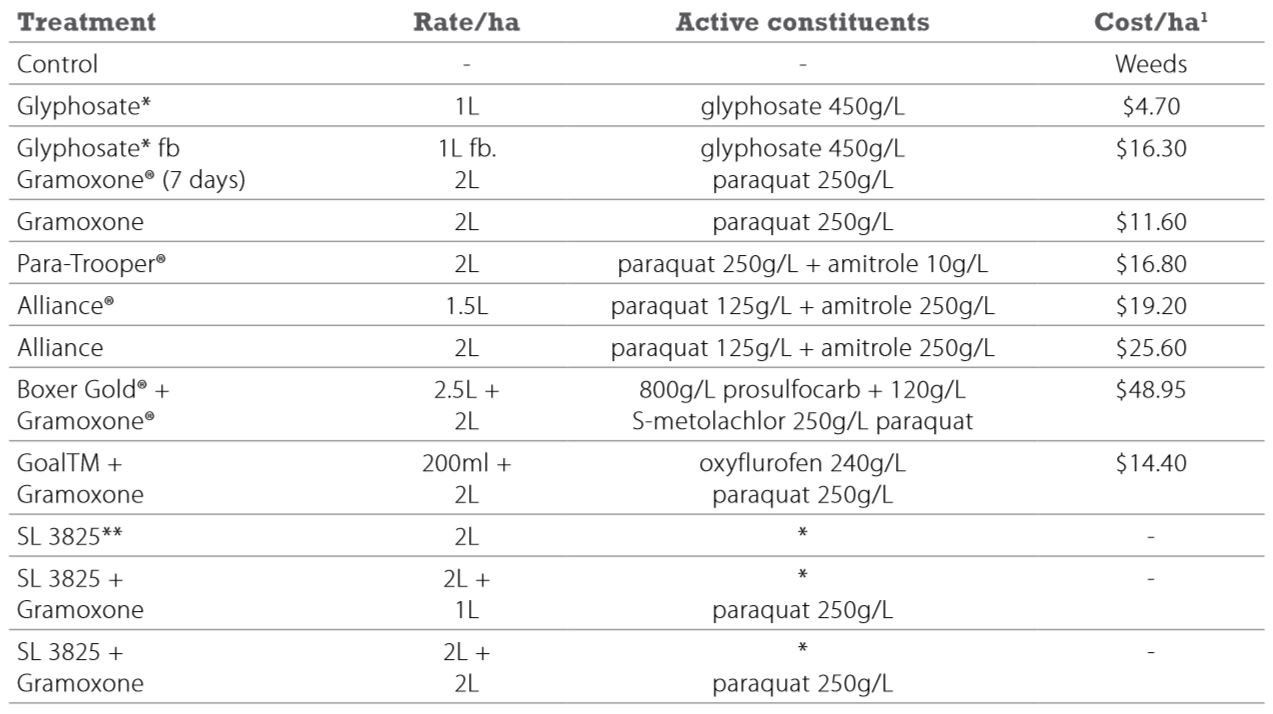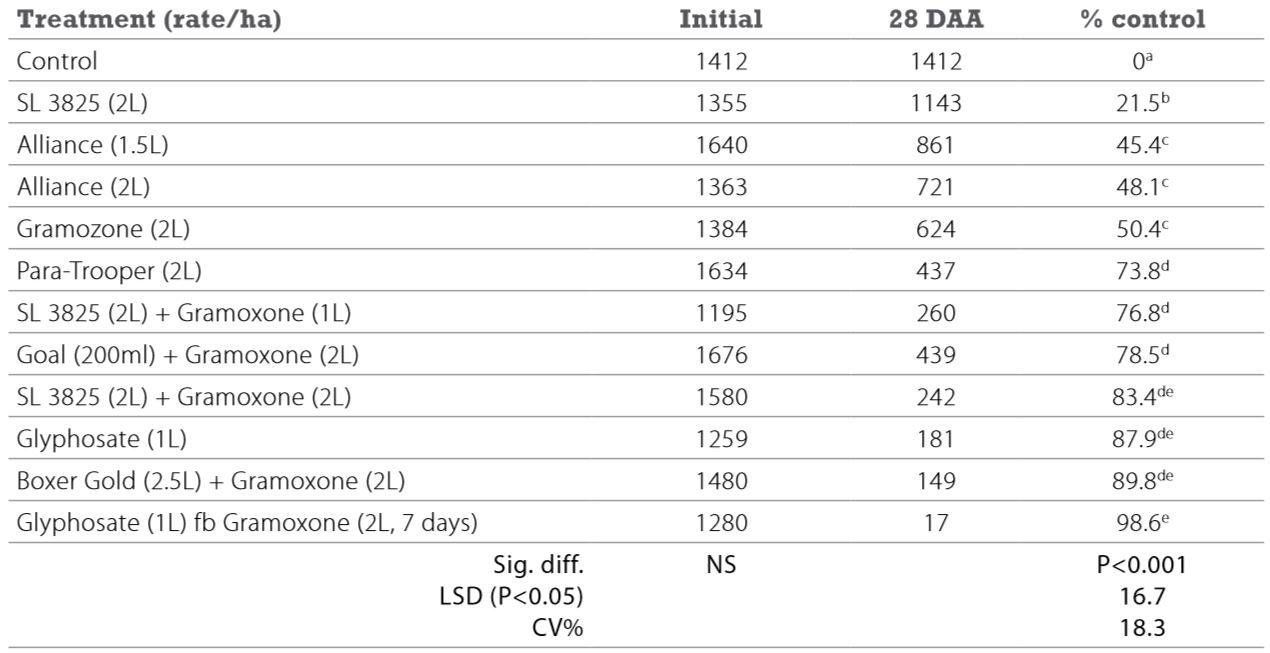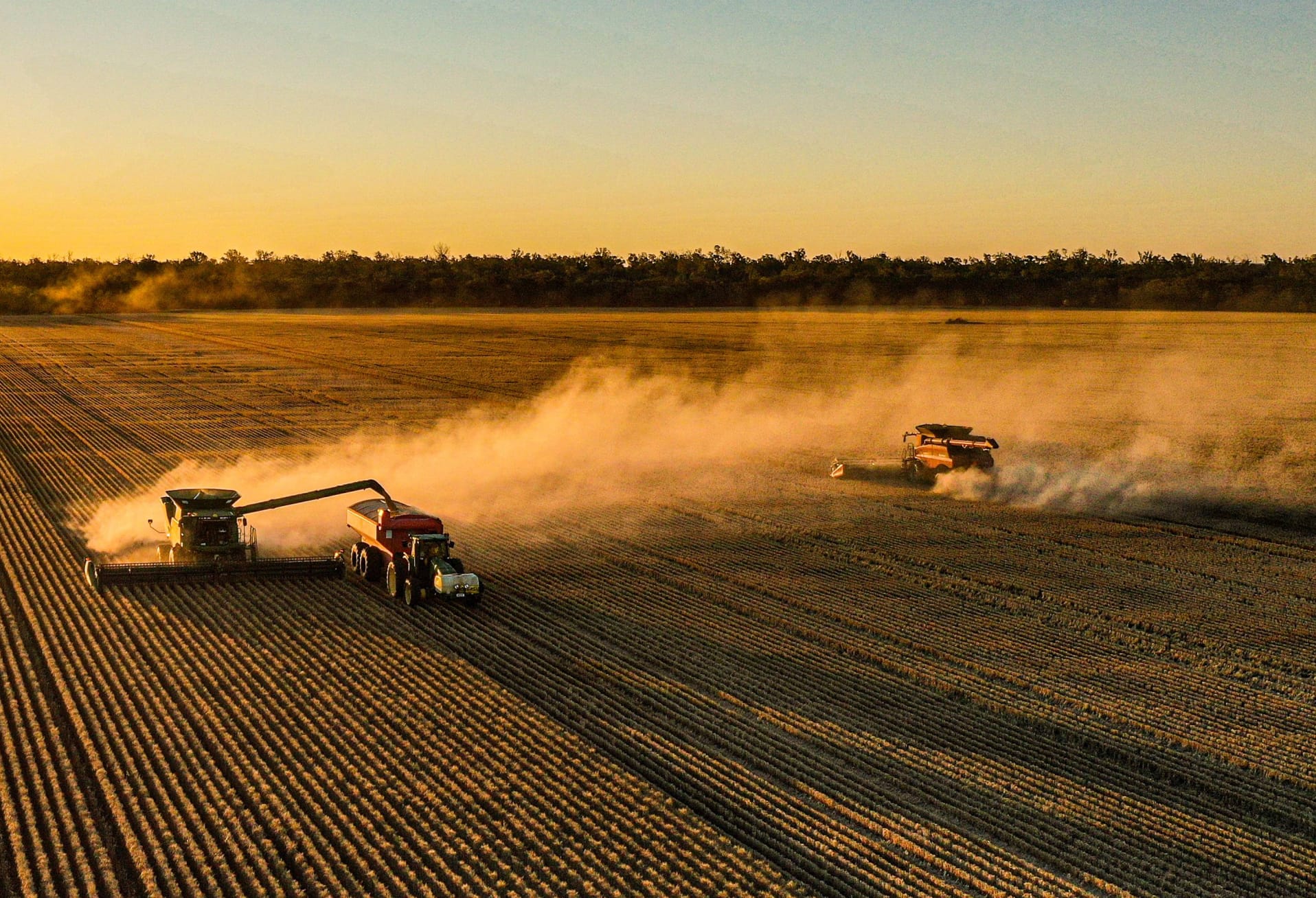Take home messages
- It is no longer a question of whether ryegrass will become resistant; it is when!
- Double knock was the most effective treatment for managing this ryegrass population (98% control).
- Alternative crop options should be integrated into the rotation to manage weeds and reduce the reliance of glyphosate.
- High water rates, spraying closer to evening and no later than 7-10 days after the initial knockdown are essential when using Paraquat.
Background
Herbicide resistant weeds are becoming increasingly common; dealing with resistance continues to present new challenges for growers. Within the Wimmera and Mallee, the widespread adoption of notill farming practices has resulted in increased herbicide resistance. Annual ryegrass (Lolium rigidum) is among a number of weed species more commonly exhibiting herbicide resistance. It is now one of the major threats to the future of Australian cropping systems in the medium to high rainfall zone.
It is critical to manage ryegrass before a crop has even been sown. Ryegrass will emerge quickly following a good autumn break, presenting (depending on your sowing time and conditions) an excellent opportunity for its control. Knockdown herbicides, largely in the form of glyphosate, have been the main tool used to deal with ryegrass prior to sowing. However, to the concern of many growers and advisers, the incidence of commercial populations exhibiting glyphosate resistance is increasing within the Wimmera and Mallee. Consequently, growers are looking for alternative knockdown options.
To improve understanding and knowledge of alternative knockdown herbicide options available to control ryegrass, a trial was undertaken in the Wimmera in 2015. The ryegrass population of the neighbouring paddock (500m away) to the trial was sampled, via seed collection, and found to contain resistance of 35 per cent to 1L/ha of glyphosate 450, and 25 per cent to 1.5L/ha. It was still controlled at 2L/ha. In other words, one in every four plants was not controlled by 1.5L/ha, the common rate used prior to sowing.
The trial provided growers and advisors with information about the various available options and the ways in which they will contribute to managing ryegrass and prolonging the effectiveness of glyphosate.
Aim
To investigate the effectiveness of the use of different herbicides and spraying regimes prior to sowing in controlling annual ryegrass and to increase grower awareness of rotating the various knockdown options pre-sowing.
Trial details
Location: Lillimur, west of Kaniva
Weed growth stage: ryegrass 2 leaf – early tillering (odd plant more advanced)
Weed population: 1500 plants/m2
Developing resistance status (based on sampled area):
35% resistance to 1L/ha glyphosate 450
25% resistance to 1.5L/ha glyphosate 450
Fully susceptible to 2L/ha glyphosate 450
Sprayer setup: TeeJet AIXR110025 nozzles @ 3bar (very coarse droplets) 100L/ha water rate
Spraying conditions: First application (3 June, 11am-2.30pm) 18°C, sunny, wind 3km/h E, humidity 46%, 8mm rain next day
Second application (10 June, 11.30-11.45am) 16°C, 40-60% cloud cover, wind 12km/h SE, humidity 60%
Method
The trial at Lillimur (west of Kaniva) was established to mimic, as closely as possible, standard farmer practice, although the selected nozzle may have been a little coarser than is commonly used. Growers should be aiming for medium to coarse droplet size to manage drift. Plots were 20m long by 6m wide and located in a relatively uniform area of the paddock as a completely randomised block design. The paddock selected was neighboring the paddock screened for resistance to allow selection of a more uniform ryegrass population over the whole trial site. Treatments were applied as described in Table 1. The trial included a low rate glyphosate treatment (1L/ha) to demonstrate the effects of sub-lethal knockdown herbicide use and to highlight the risks that are developing or are already established in farming systems.
Assessments included pre-spraying counts and post application counts at 7, 14 and 28 days after application (DAA).
Table 1. Treatment list, active constituents and their associated costs.
*AMS (1%) + Li700 (0.25%) were added to all glyphosate treatments and BS1000 (0.2%) added to the SL3825 alone treatments. ** SL3825 not commercially available. 1Prices based on average of two local reseller comparison and only a guide.
Results and interpretation
The ryegrass population in this trial was very high. The trial site had an even cover of ryegrass plants ranging from two leaf to mid tillering, with the majority at one tiller. Growers should be targeting ryegrass no later than this stage.
Results (shown in Table 2), show that the best option was to use a double knock strategy, with greater than 95 per cent control at 28 DAA. Glyphosate also performed well, showing a better result than the resistance testing suggested. However, the existence of survivors suggested that resistance to glyphosate was developing.
Another herbicide mix which provided acceptable levels of control was the Boxer Gold + Gramoxone brew, which delivered an almost 90 per cent reduction in plant numbers. An 8mm rain event the day after application (DAA) would have greatly improved the performance of Boxer Gold on the small ryegrass plants. An added benefit would have been the residual control that Boxer Gold provides early in the crop cycle, although this would be dependent on the density of the weed population and success in incorporating it or the product being washed in by rain. Such events are critical to the effectiveness of Boxer Gold, which relies heavily on root uptake for control. Nevertheless, using Boxer Gold in combination with Gramoxone can provide an opportunity to utilise a double knock strategy, while delivering pre-emergent chemistry in two passes rather than three. In this instance it was, however, a costly option.
Para-Trooper was another product that offered promising results. It has the same amount of active ingredient as Gramoxone (paraquat 250g/L) but in addition, contains a low rate of amitrole (10g/L).
The addition of the amitrole, appeared to improve control from 50 per cent with paraquat alone to 74 per cent control at 28 DAA, however this is results from one season and other products with the same actives such as Alliance did not have the same effect.
Alliance in this trial did not deliver acceptable levels of control. Monitoring at 7 and 14 DAA revealed noticeable bleaching of new growth, but by 28 DAA the ryegrass appeared to have recovered and the bleaching effect had been lost. It is important to note that the key differences between Alliance and Para-Trooper are the concentrations of both actives (Table 1). The higher concentration of paraquat in Para-Trooper could have resulted in more effective burn-down of the ryegrass population, and hence the better outcome.
The poor performance of paraquat alone could be due to a number of factors. Lower rates of paraquat have often been shown to be ineffective in controlling larger weeds, and the density of the weed population could have produced shading. It is also possible that the droplet size used in the trial was slightly too coarse to facilitate optimum herbicide activity. The considerable differences between products containing paraquat alone, and those containing amitrole as well, would be worth looking at over more seasons to determine whether this was an effect of some of the above-mentioned factors.
Adding oxyflurofen (Goal) to paraquat (Gramoxone) also improved the level of control compared with paraquat alone (78% at 28 DAA). This again comprised a significant improvement for a small increase in cost. The rate of oxyflurofen used, however, is in excess of label spike rates and therefore would come with increased plant back risks, particularly for sensitive crops, and would therefore not be commercially acceptable prior to sowing.
The new chemistry SL3825 did not perform well on its own. Its effectiveness was constrained by the size of the ryegrass; the product being developed specifically to target pre-tillering ryegrass. When used in combination with paraquat, the level of control significantly improved. Although control of ryegrass was limited, it did show impressive control of broadleaf weeds such as vetch. Work is in progress on this product to determine the best use patterns (timing and adjuvant selection) to target ryegrass.
Table 2. Ryegrass counts plants/m2 and % control 28 days after application (DAA).
To build on this research and develop further understanding, future work could be undertaken into looking at the effectiveness of some double knock mixes and how they might contribute towards ryegrass control. It would also be worthwhile investigating the influence of water rates, and possibly water quality, on the efficacy of these products and/or tank mixes. Revisiting products that performed less well than may have been expected in this trial would also help to clarify whether the poor growing season conditions hindered their effectiveness, or whether they just don’t have enough strength in their own right and need a little more care in their use.
Commercial practice
The trial reinforces how important glyphosate is to the agricultural industry, but how quickly its usefulness is slipping from our grip. The presence of survivors in this trial, and in the neighbouring paddock with confirmed resistance, highlighted that growers cannot afford to be complacent about its use. The longevity of glyphosate is crucial to the continued success in farming systems’ weed management programs: the use of such a product should always be within an integrated weed management program that utilises a range of both herbicide and non-herbicide tactics.
Currently, the “double knock” represents the most important technique to control glyphosate resistant ryegrass, a fact which this trial demonstrated once again. What can be taken further from this trial are ways in which it is possible to make the double knock technique more robust. The vast majority of double knock spray programs are currently carried out with paraquat applied on its own as the second spray. This trial showed that by using other mixes, potentially as a double knock following a glyphosate application, it is possible to improve control at only slightly greater expense than by using paraquat alone. Products which rely largely on contact action for their effectiveness should be applied with care. Paraquat based products provide best results when used with high water rates and a medium to coarse droplet to manage drift. A small amount of systemic action can also be obtained if spraying is carried out near evening, which allows the product to spread overnight on the leaf before being activated by the sun the next day. If a double knock is being used to target ryegrass, a split of no more than 7-10 days is recommended for best results.
It should also be remembered that paraquat is being subjected to increasing pressure to perform in ryegrass populations, which in effect will put it at high risk of resistance. This is already occurring in some areas of southern Australia. An integrated approach that aims for zero weed seed set is the best way to combat the increasing pressure on herbicides. Consequently, other tactics such as strong crop competition, harvest weed seed management and hay options should be considered before herbicides begin to fail.
On-farm profitability and risk
As the number one weed in southern Australia, the effective control of ryegrass drives profitability on farms. Growers have no choice but to gain high levels of control if they are to increase, or even maintain, profitability. Developing and improving the double knock technique, or having other viable alternatives, whether chemical or cultural, is vital. The adoption of such methods must become a widespread practice in many parts of Southern Australia in the next few years if farmers are to keep on top of weed populations.
Currently, costs to adequately control ryegrass can vary markedly, but some options enable a reduced number of passes. However, decisions relating to ryegrass control need also to take into consideration the long-term consequences of continuing with the status quo.
When considering on-farm profitability and risk, remember:
- Currently, compared with the alternatives, glyphosate is cheap. But if it is the only thing used, then resistance will occur.
- Losing glyphosate will be expensive across the farm; it is better to use some alternatives strategically to manage incipient resistance before it becomes a widespread problem.
- When compared with alternative single herbicide options, the double knock of glyphosate followed by paraquat is reasonably priced and most effective. It should be used when sowing conditions allow.
Acknowledgements
This trial was funded by the GRDC as part of the ‘Agribusiness Trial Extension Networks: Identify options for the control of glyphosate resistant ryegrass’ project (CLO00001).


